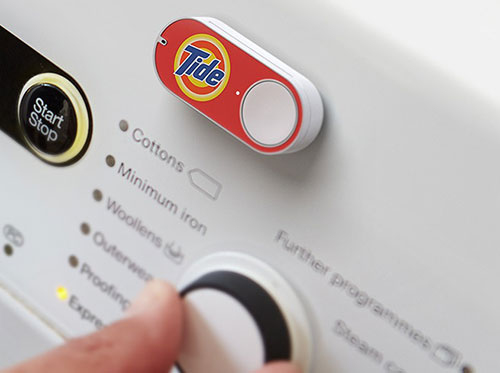Does the thought of running out of Tide wake you in cold sweats? Is your greatest fear an afternoon spent hustling to the store for more Quaker Oats? In April of 2014, Amazon introduced something called the Dash, a carrot-sized contraption that allows consumers to zap the barcodes off their empty cereal boxes, or, when that’s too difficult, simply speak the names of needed products into a microphone to order more. But talking or waving a stick around takes energy—energy that may not be available after the depletion of your life-giving cereal bar supplies—so, thankfully, on March 31, 2015, Amazon streamlined theses arduous tasks by introducing the Dash Button. Simply place the Button next to a thing you use a lot of, such as toilet paper or laundry detergent, enable the smartphone app, and connect everything to your wireless network. Now any time your product levels run dangerously low, simply punch the Button and, in two to five days, you can restock your shelf. Get a Dash for everything you buy!
Combine this with the Amazon Echo, Amazon’s answer to Apple’s Siri, released in November of 2014, and life gets even simpler. Think of Echo as the personal assistant you never needed. The cylinder-shaped device plays your awesome music from the speaker at its perforated waist while at the same time updating your calendar, answering your random sports questions, and adding things to your Amazon shopping list. All you have to do is ask, even over the blare of your Saturday Morning Limp Bizkit mix. Echo’s seven microphones—which are always on—promise to detect your normal speaking voice from across the room, no matter who you’re actually talking to, or what you’re saying.
At the same time that Amazon was quietly introducing these products (most are only available to select Prime members), it was also introducing its Home Services. The Home Services program, unveiled on March 30, 2015, provides vetted and ranked contractors for everything from plumbing to tuba lessons, depending on your service area. The providers remain independent of Amazon, except that Amazon requires them to provide upfront pricing or estimates, pay a cut of between 10 and 20 percent of their fees, and provide a money-back guarantee on all services.
You may be wondering how all this relates to publishing. Well, it’s a long shot, but bear with me …
The big news in the publishing world right now is the inability of HarperCollins and Amazon to reach a new contractual agreement. According to Business Insider (a trade magazine that just happens to count Bezos as an investor, and was the only one to break this story), talks aren’t going too smoothly between the two companies. However, it seems HarperCollins may have already begun preparing for this battle. Back in 2013, it began developing its own channels of distribution, such as online storefronts at HarperCollins.com, which sells both print and ebooks, and Narnia.com, which exclusively sells the works of C.S. Lewis. The publisher also made its ebooks available through subscription services such as Oyster and Scribd. At the same time, HarperCollins acquired Harlequin Books, purchased a majority of stock in Thomas Nelson Brasil (a Christian book publisher), and began selling print and ebook bundles.
Here’s the publishing tie-in: If Amazon is able to integrate itself into consumer lives to the degree it seems to be going for, the channels through which consumers purchase products not offered by Amazon may become increasingly sparse. When desire and effort are removed from the consumer experience, then what will drive consumers to physically engage with their internet devices (or feet) in order to search out and buy products not offered by Amazon? Shopping might become so quaint and old-fashioned that merchants like HarperCollins, relying on the consumer to come to them, will seem passé. If Amazon is successful, publishers (and any other producers) may have no choice but to work with it, and Amazon will have final say in all negotiations. Amazon’s endeavor into the “Internet of Things” (as the networking of appliances in your home is called) speaks of a larger threat. It suggests a company—a book seller in our case—on the edge of becoming a true monopoly, and that’s a scary thought. As a small publisher, we need to be able to keep our options open—it’s the only way we survive.

